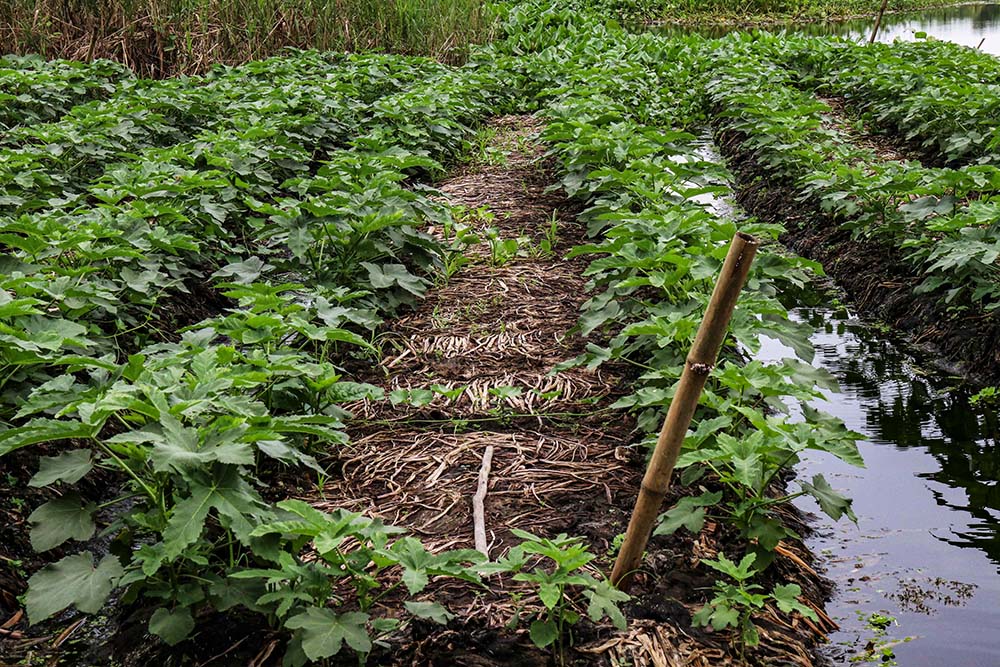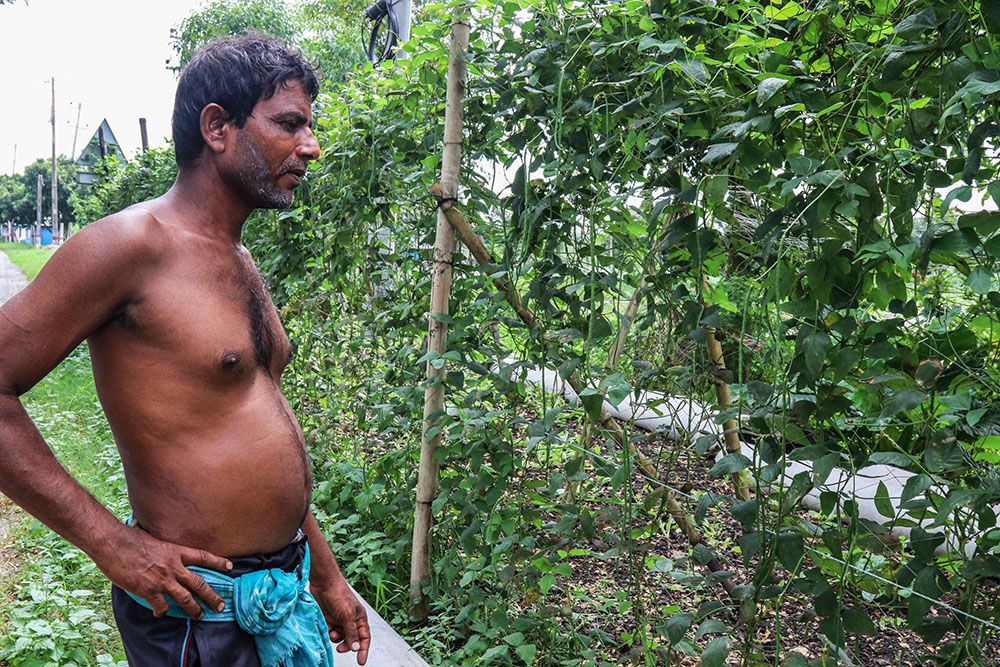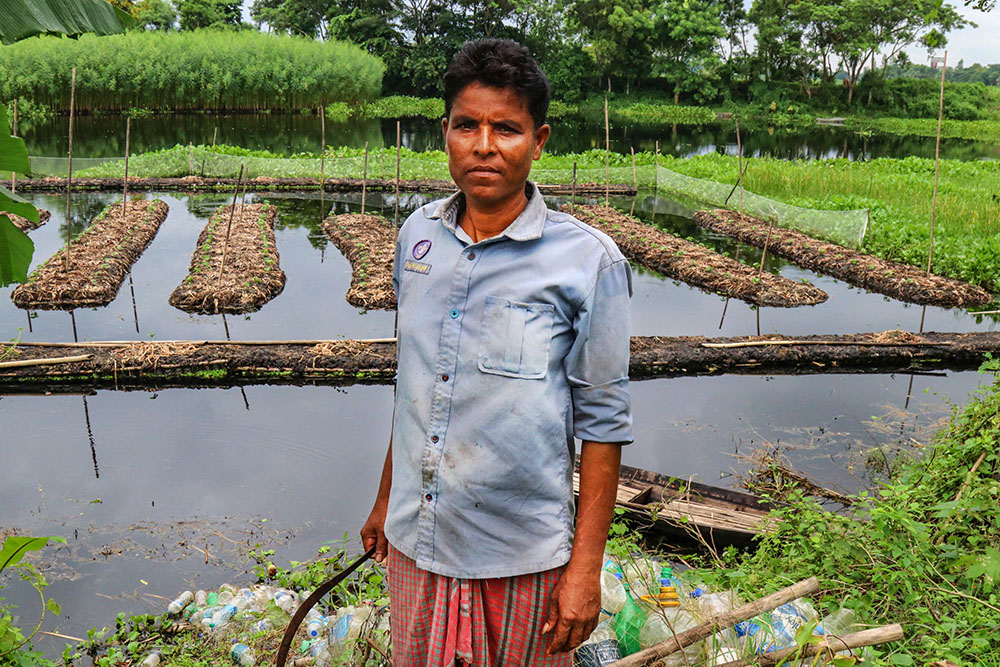
Farmers are making floating gardens in waterlogged coastal areas in Bangladesh. (Stephan Uttom Rozario)
A centuries-old technique for growing floating beds of vegetable crops is gaining popularity in Bangladesh's southern coastal districts, a response to flooding and sea rise worsened by climate change in this low-lying country.
Situated on the Bay of Bengal and within the Ganges-Brahmaputra-Meghna river basin, Bangladesh is prone to flooding and experiences an intense annual monsoon season. Such storms are becoming more extreme and frequent due to rising global temperatures. In its southern regions, some parts are inundated with water for parts of the year while others are submerged for most of it.
The increasingly wet conditions have forced farmers to adapt, within a country seen as a global leader in climate adaptation, and have led some to grow vegetables literally on the water.
The floating beds are weaved out of water hyacinth — a perennial, and buoyant, plant with spongy, green leaf clusters and purple flowers. Originally native to South America, it is considered the most invasive aquatic plant species on the planet. Its ability to quickly overtake lakes and other bodies of water has earned it nicknames like "the terror of Bengal," where it is believed to have been first introduced in the late 19th century before quickly overwhelming its waterways by the 1920s.
The practice of creating floating beds to grow crops dates back more than 200 years in Bangladesh, with farmers employing various methods, like making rafts from paddy stalks.

Farmers cultivate crops like turnips, cabbage, cauliflower, tomato, lady's finger and red amaranths in the floating gardens. (Stephan Uttom Rozario)
In the case of water hyacinth, they're using hydroponics to turn a pest into a problem-solver. The technique has gained traction, especially among farmers who lack land due to rising water levels and environmental degradation.
"Farmers are benefiting themselves through floating gardens [and] nature is being protected," said Daud Das, program director for Caritas Bangladesh, which has supported the aquatic growing method.
According to the agriculture office in the Tungipara subdistrict, in southern Bangladesh, currently about 800 farmers are cultivating floating beds on 180 hectares of land in the region and about 1,500 floating beds have been created so far this year.
In their floating gardens — with beds stretching as much as 30 feet long and 8 feet wide — farmers cultivate crops like turnips, cabbage, cauliflower, lady's fingers (okra), tomatoes and red amaranth.
Pijush Kumar Biswas, a farmer and father of three from the Tungipara area of Gopalganj, grows his floating beds on his land and in government reservoirs.

Pijush Kumar Biswas, a farmer, shows his garden where he uses rotting water hyacinth as a natural fertilizer. (Stephan Uttom Rozario)
"I saw my father and grandfather making this bed in the canal next to the house to meet the family's food needs throughout the year. But I have taken it up as a profession," in order to cover family expenses for food, medicine and education, he told EarthBeat.
Along with the national government and nongovernmental organizations, Caritas Bangladesh has promoted floating vegetable farming as a means to protect the environment and stem migration driven by climate change.
"Caritas Bangladesh provides encouragement, training and financial support to poor farmers at the field level to cultivate vegetables in water, farming on bare land and even on the banks of ponds," said Francis Bepari, director of Caritas Bangladesh's regional office in Barisal.
Caritas has especially encouraged farmers in the rural coastal areas to grow floating gardens. Places where water accumulates for months, or even half the year, benefit the most, Das said.
Bangladesh's coastal region, which covers a third of the country's land area and where roughly 20% of the population resides, has become even more waterlogged due to climate change, Bepari told EarthBeat.
Sea levels in Bangladesh are rising faster than the global average, at roughly 4-6 millimeters each year, and by the end of the century 12% to 18% of its coastal area could be underwater, according to a February report from the International Centre for Climate Change and Development. Rising seas, and related disappearing land, is projected to displace nearly 1 million people in the southern part of the country by 2050, the report found, as well as pose devastating consequences for vital food crops.
While flooding has already forced displacement of people in some cases, it also has made floating gardening and paddy cultivation more profitable while at the same time helping ecosystems by increasing plantlife and decreasing the need for chemical fertilizers.
Advertisement
Due to a lack of funding, Caritas has ended its floating garden program, though it still supports farmers it trained.
"If Caritas Bangladesh gets more donors, then we can make this floating garden method more popular among farmers," Das said. "We need to pay more attention to the environment [as] Pope Francis emphasizes."
For Pijush Kumar Biswas, building three beds cost him roughly 20,000 taka (US$167), from which he hopes he can earn up to 150,000 taka (US$1,255). Beyond an income source, he sees numerous benefits in growing floating garden beds.
"First of all, I am producing crops in the government [land] next to my house, which costs less, and I can eat pesticide-free crops. And secondly, this rotten bed is doing the work of fertilizer in my land as well," he said.
Quader Sardar, agricultural training officer for the Gopalganj district, said offices like his are working to make vegetable and spice cultivation more popular within floating beds for farmers. The District Agriculture Extension Directorate has also provided farmers with training.

Farmers pick vegetables from their floating gardens and sell them by the roadside and to wholesalers from the city. (Stephan Uttom Rozario)
Outside of Gopalganj, other coastal districts like Pirojpur, Bagerhat, Barisal and Madaripur, are seeing a rise in floating farming.
For people in these areas without their own land, they often do commercial farming in government canals.
Agriculture is one of the most important industries for Bangladesh's economy. In 2022, nearly roughly 37% of workers were employed in agriculture, which made up roughly 11% of its gross domestic product.
With a population of 170 million, Bangladesh is one of the poorest and most densely populated countries in the world. An estimated 4,024,000 households are landless, with the majority located in rural areas, according to data from the 2019 national census.
The threat of disappearing land due to rising seas from climate change has led some farmers to leave agriculture and look for alternative means of livelihood, while others are finding work in the garment industry, factories or shrimp farms.

Tapan Biswas, a farmer who received training from Caritas Bangladesh, forms his floating beds using empty plastic bottles, which he ties together to form a platform he then covers in water hyacinth. (Stephan Uttom Rozario)
Tapan Biswas, 42, who also lives in the Tungipara, Gopalgonj area, received training from Caritas Bangladesh, though he employs a different base material to form his floating beds: empty plastic bottles, which he ties together to form a platform he then covers in water hyacinth.
Since Tapan Biswas has no land of his own — eliminating the ability to use the rotting hyacinth to fertilize other crops — this approach allows him to reuse the plastic bases to grow new gardens for several years.
He borrowed 20,000 taka (US$167) to build three beds.
"From this bed, I can sell vegetables in the market within 45 days," Tapan Biswas said. "Since I don't have any land of my own, I will harvest from here for at least 10 months. Later, I will repair it again by putting some water hyacinth on it."
Although he has studied up to 10th grade himself, the farmer hopes his agricultural work will allow his only child to at least graduate.
"I am self-sufficient because now I do not go to work on other people's land," he told EarthBeat. "But I sometimes let people work in my floating vegetable garden."




